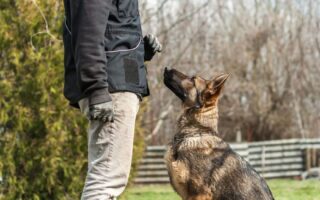Every dog owner knows the joy of a brisk walk with their furry friend, the rhythmic patter of paws on pavement, the fresh air, and the bonding moments shared along the way. However, for many, this simple pleasure can quickly turn into a tug-of-war match, with their energetic companions pulling at the leash like it’s a game. This common challenge can transform daily strolls into frustrating escapades, creating a disconnect between the pet and their owner. Thankfully, there are effective solutions that not only promote better leash manners but also enhance the walking experience for both parties. In this article, we’ll explore the best strategies and tools to combat leash pulling, ensuring that every walk is a harmonious adventure filled with discovery and joy. Join us as we delve into expert tips, innovative training techniques, and the latest gear designed to turn those challenging walks into enjoyable jaunts.
Table of Contents
- Understanding the Causes of Leash Pulling Behavior
- Effective Training Techniques to Curb Leash Pulling
- The Role of Equipment in Managing Leash Pulling
- Creating a Consistent Walking Routine for Success
- Q&A
- The Conclusion
Understanding the Causes of Leash Pulling Behavior
Understanding why dogs pull on the leash is crucial for addressing this common issue. The behavior often stems from a combination of natural instincts and environmental factors. Dogs are naturally curious creatures, eager to explore their surroundings. When they see something intriguing—be it a squirrel, another dog, or even a pleasant scent—they may instinctively pull ahead. Additionally, if a dog is not adequately socialized or lacks training, it can lead to overexcitement during walks, resulting in pulling. Factors such as age, breed, and energy level also play significant roles in how likely a dog is to pull on the leash.
To effectively manage and reduce leash pulling, it’s essential to recognize the underlying motivations behind the behavior. Here are some common causes:
- Excitement: Dogs may pull in anticipation of play or new experiences.
- Anxiety: Fearful dogs may pull to escape situations they find uncomfortable.
- Overstimulation: A busy environment can cause heightened senses, leading to erratic pulling.
- Lack of Training: Insufficient leash training can lead to poor walking manners.
Understanding these factors allows dog owners to implement strategies that address the root causes rather than just the symptoms of leash pulling.
Effective Training Techniques to Curb Leash Pulling
One of the most effective methods to combat leash pulling is by implementing positive reinforcement techniques. This involves rewarding your dog with treats, praise, or play whenever they walk beside you calmly. Consistency is key—if your furry friend starts pulling, stop walking immediately. Wait until the leash is slack before moving forward. Over time, your dog will learn that staying close to your side leads to more enjoyable walks, while pulling results in a halt. Another strategy is to utilize the ‘Turn and Go’ method; when your dog begins to pull, simply turn in the opposite direction and walk away. This teaches them to pay attention to your movements and creates a more engaging walking experience for both of you.
Additionally, employing the right equipment can significantly aid in reducing pulling behavior. Consider using harnesses specifically designed to discourage pulling or head halters that redirect your dog’s attention. These tools can provide better control without discomfort. Pairing the right gear with a structured training schedule will result in quicker progress. Here’s a simple training timetable to keep you on track:
| Day | Activity | Duration |
|---|---|---|
| 1 | Loose-leash walking in a low-distraction area | 15 minutes |
| 2 | Practice ’Turn and Go’ exercise | 10 minutes |
| 3 | Short, rewarding sessions with treats | 5 minutes |
| 4 | Introduce distractions (gradually increase) | 20 minutes |
| 5 | Repeat previous exercises | 15 minutes |
Remember, patience and practice are essential. As your dog becomes more accustomed to these techniques, both of you will enjoy more peaceful walks.
The Role of Equipment in Managing Leash Pulling
When it comes to managing leash pulling, the right equipment can make a world of difference. Various tools are specifically designed to help both you and your dog enjoy walks without the struggle of tugging and pulling. Among the most effective options are:
- No-Pull Harnesses: These harnesses distribute pressure evenly across the dog’s body, discouraging pulling behavior without causing injury.
- Front-Clip Harnesses: With the leash attachment at the front, these harnesses redirect your dog’s movement towards you, making it harder for them to pull forward.
- Head Collars: Designed to gently guide the dog’s head, they allow for better control and help teach leash manners.
- Leash Training Tools: Items such as training leashes with additional control handles or shock-absorbing sections can provide you with better management of your dog’s movements.
Each piece of equipment serves its purpose in making walks more enjoyable and manageable. Choosing the right products can greatly enhance your training efforts. Consider the following factors:
| Equipment Type | Benefits |
|---|---|
| No-Pull Harness | Comfortable and effective in reducing pulling |
| Front-Clip Harness | Redirects pulling and promotes better behavior |
| Head Collar | Allows for more control and guidance during walks |
| Training Leashes | Provides additional control and comfort for both owner and dog |
Creating a Consistent Walking Routine for Success
Establishing a walking routine that you and your dog can rely on is essential for alleviating pulling on the leash. Start by setting specific times each day for your walks, helping your dog understand when to expect these moments. Consistency not only creates structure but also builds anticipation. Consider utilizing a flexible schedule that accommodates daily variations while maintaining the overall walking frequency. This could include:
- Mornings: A brisk walk to energize your dog for the day.
- Afternoons: A short walk for social stimulation.
- Evenings: A relaxing stroll to wind down the day.
In addition, focus on keeping your walks engaging and enjoyable. Use positive reinforcement, such as treats or praise, when your dog stays by your side. Incorporate training techniques throughout the walk to reinforce desired behaviors. You may even want to track your progress using a simple table that outlines the walking days and your dog’s pulling behavior. This way, you’ll see improvements over time.
| Day | Leash Behavior | Notes |
|---|---|---|
| Monday | Moderate Pulling | Utilized treats effectively. |
| Wednesday | Minimal Pulling | Increased duration of walk. |
| Friday | No Pulling | Great engagement with rewards! |
Q&A
Q&A: Finding the Best Solution for Dog Pulling on Leash
Q1: What causes dogs to pull on the leash?
A: Dogs pull on the leash for various reasons, including excitement, curiosity, or simply because they haven’t learned proper leash manners. Some dogs may be naturally inclined to lead the way, while others might pull in response to distractions, like other dogs, people, or smells along the path.
Q2: Why is it important to address leash pulling?
A: Addressing leash pulling is crucial for both the dog’s safety and the handler’s control. A pulling dog can lead to accidents, injuries, and an unpleasurable walking experience. Proper leash manners foster a positive bond between the dog and owner and promote a more enjoyable outing for both.
Q3: What are some effective training techniques to reduce pulling?
A: Here are some tried-and-true techniques:
- Positive Reinforcement: Reward your dog with treats and praise when they walk calmly beside you. This encourages them to associate loose-leash walking with positive experiences.
- Stop-and-Go Method: If your dog pulls, stop walking entirely. Wait until they return to you or loosen the leash before continuing. This teaches them that pulling won’t get them where they want to go.
- Change Direction: If your dog pulls, suddenly change direction. This not only catches them off guard but also encourages them to pay attention to you and follow your lead.
Q4: Are there any tools that can help with leash pulling?
A: Yes, there are several tools designed to help manage leash pulling:
- No-Pull Harnesses: These harnesses clip at the front rather than the back, redirecting the dog’s movement toward you when they pull.
- Head Halters: These work like a collar for the head and can provide excellent control without causing discomfort.
- Leash Training Collars: Devices such as martingale collars can prevent pulling while ensuring safety and comfort.
Q5: How can consistency in training impact leash walking?
A: Consistency is key in any training regimen. Regular practice with consistent commands, rewards, and techniques will help your dog understand what is expected of them. Make sure all family members use the same methods to avoid confusion. It creates a cohesive experience that reinforces learning.
Q6: How long should I expect the training to take?
A: The duration of training can vary significantly based on the dog’s age, temperament, and previous experiences. Some dogs may show improvements in a matter of days, while others might take several weeks or even months. Patience and persistence are essential — every small step toward improvement counts!
Q7: Are there any specific breeds that are more prone to pulling?
A: Certain active breeds, such as Siberian Huskies, Labradors, and Beagles, may be more prone to pulling due to their high energy and independent nature. However, any dog can exhibit pulling behavior if not properly trained. Understanding your dog’s specific traits can aid in customizing your approach.
Q8: What should I do if I feel overwhelmed by training my dog not to pull?
A: If you find yourself feeling overwhelmed, consider seeking help from a professional dog trainer. A trainer can provide personalized guidance, strategies, and hands-on instruction to help you and your dog navigate the challenges of leash manners effectively.
Q9: How can an owner ensure they remain calm during training sessions?
A: Remaining calm during training is essential for effective communication. Take deep breaths, remember that training takes time, and allow yourself occasional breaks if you feel frustrated. Celebrating small victories — whether it’s a few successful steps or a focused moment — can help keep both you and your dog motivated.
Q10: what is the most crucial takeaway for those dealing with a pulling pup?
A: The most crucial takeaway is that patience and perseverance are your best allies. It’s normal for dogs to pull at first, but with consistent training, clear communication, and a commitment to positive reinforcement, you can transform your walks into enjoyable experiences for both you and your furry friend. Ultimately, the journey of training is as important as the destination, enriching the bond between you and your dog.
The Conclusion
In the journey of dog ownership, teaching your furry companion to walk politely on a leash is both a rewarding and essential endeavor. Whether you opt for positive reinforcement techniques, specialized training tools, or professional guidance, the key takeaway is patience and consistency. Remember, every dog learns at their own pace, and the bond you strengthen through this training will enhance your walks together. With determination and the right approach, those tugging moments will transform into peaceful strolls, allowing you and your canine friend to explore the world side by side. So, lace up those shoes, grab the leash, and embark on this path towards harmonious outings—there’s a whole world waiting for you both to discover, one well-behaved step at a time.


